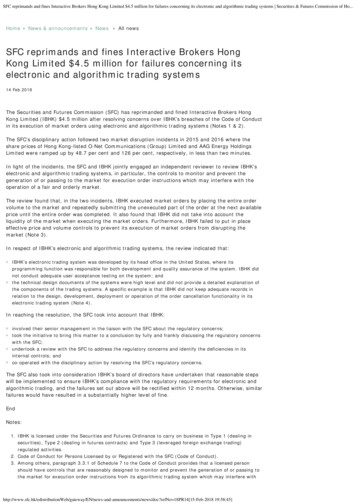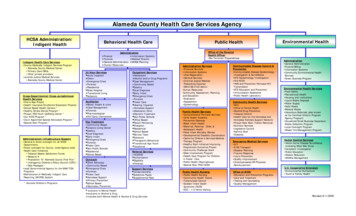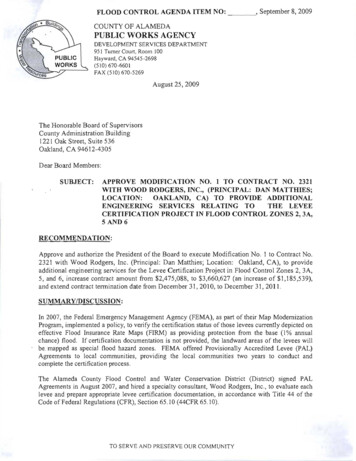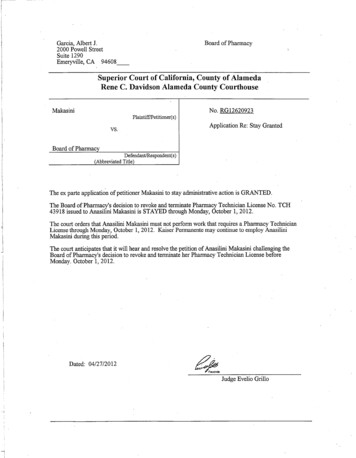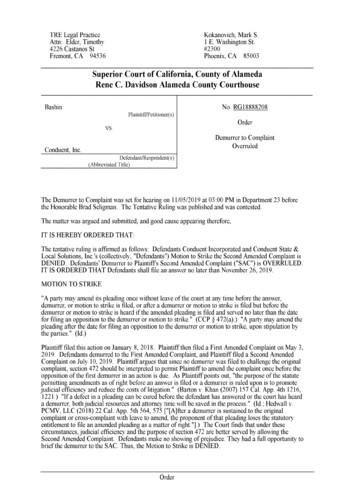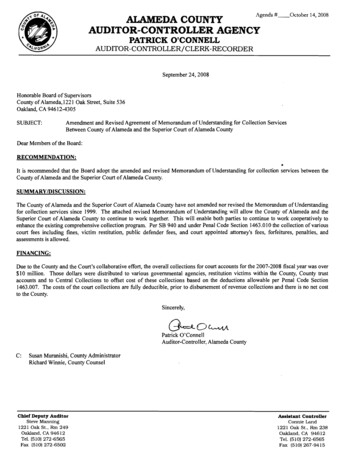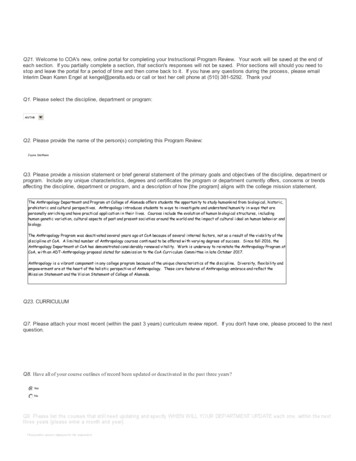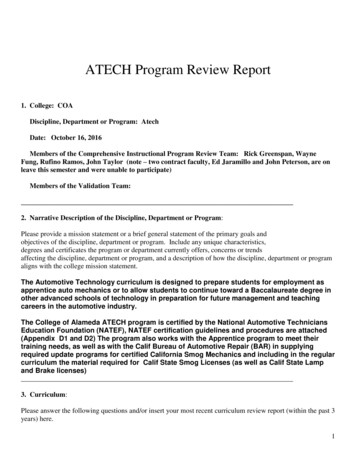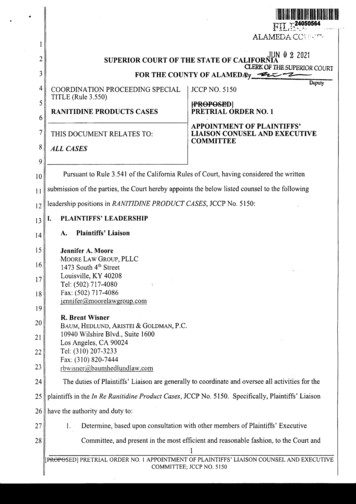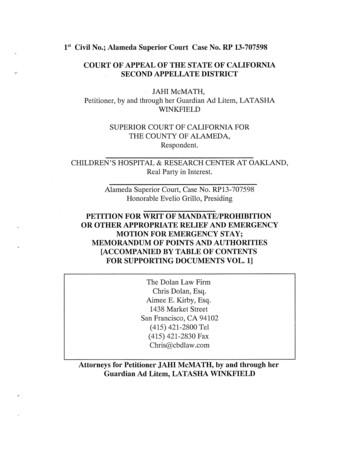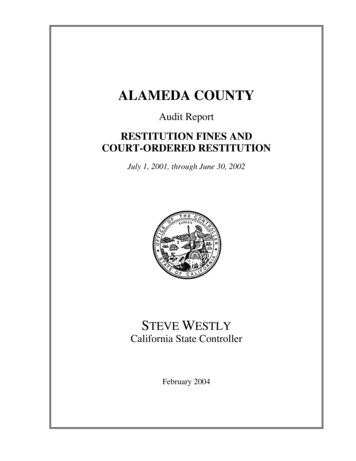
Transcription
ALAMEDA COUNTYAudit ReportRESTITUTION FINES ANDCOURT-ORDERED RESTITUTIONJuly 1, 2001, through June 30, 2002STEVE WESTLYCalifornia State ControllerFebruary 2004
STEVE WESTLYCalifornia State ControllerFebruary 25, 2004The Honorable Patrick O’ConnellAuditor-ControllerAlameda County1221 Oak Street, Room 249Oakland, CA 94612Mr. Art SimsCourt Executive OfficerAlameda County Superior Court1225 Fallon Street, Room 209Oakland, CA 94612Dear Mr. O’Connell and Mr. Sims:The State Controller’s Office has completed an audit to determine the propriety of courtrestitution fines reported to the State of California and court-ordered restitution reported to theVictim Compensation and Government Claims Board by Alameda County for the period ofJuly 1, 2001, through June 30, 2002.The audit disclosed that: The county did not distribute the 10% rebate revenues to county agencies responsible forrestitution collection; and The county did not include a 10% administration fee on restitution fines.If you have any questions, please contact Jerry McClain, Chief, Special Audits Bureau, at(916) 323-1573.Sincerely,VINCENT P. BROWNChief Operating OfficerVPB:jjcc: Jim MullallyRestitution SpecialistDistrict Attorney’s OfficeCatherine Close, Executive DirectorVictim Compensation andGovernment Claims BoardLaura Hill, ManagerRevenue Recovery DivisionVictim Compensation andGovernment Claims Board
Alameda CountyRestitution Fines and Court-Ordered RestitutionContentsAudit ReportSummary .1Background .1Objective, Scope, and Methodology.2Conclusion .3Views of Responsible Official .3Restricted Use .3Schedule 1—Random Sample Results.4Findings and Recommendations.5Appendix—Transaction Flow for Court-Ordered Restitution.8Attachment—County’s Response to Draft Audit ReportSteve Westly California State Controller
Alameda CountyRestitution Fines and Court-Ordered RestitutionAudit ReportSummaryThe State Controller’s Office (SCO) performed an audit to determine thepropriety of court restitution fines reported to the State of California andcourt-ordered restitution reported to the Victim Compensation andGovernment Claims Board (Board) by Alameda County for the period ofJuly 1, 2001, through June 30, 2002. The last day of fieldwork wasJune 19, 2003.Alameda County remittances to the State Treasurer for restitution finesand warrants paid to the Board for restitution court orders were correct.The points discussed in the Findings and Recommendations section mayaffect the amount of those remittances through enhanced collectionefforts or additional fees collected.In addition, the reimbursement of court-ordered restitution is hindereddue to various reasons. For example, pursuing the reimbursement forclaims that are remitted after the sentencing date may not becost-effective due to the additional court costs involved, unless the courtsand the county are willing to implement a coordinated process among thecourts, the District Attorney’s Office, and the Probation Department.BackgroundState statutes govern the distribution of court revenues, which includerestitution fines and court-ordered restitution. Whenever the State isentitled to a portion of such money, the court is required by GovernmentCode Section 68101 to deposit the State’s portion of court revenues withthe county treasurer as soon as practical and to provide the countyauditor with a monthly record of collections. This section further requiresthat the county auditor transmit the fund and a record of the moneycollected to the State Treasurer at least once a month.Government Code Section 68103 requires that the State Controllerdetermine whether all court collections remitted to the State Treasurerare complete. Government Code Section 68104 authorizes the StateController to examine records maintained by any court. Furthermore,Government Code Section 12410 provides the State Controller withgeneral audit authority to ensure that state funds are properlysafeguarded.The Board was concerned with the accurate and effective administrationof restitution fines and court-ordered restitution with respect to the victimcompensation program. Consequently, on January 1, 2003, aninteragency agreement was made between the SCO and the Board toconduct six field audits of county and court collection systems as theyrelate to restitution fines and court-ordered restitution.Steve Westly California State Controller1
Alameda CountyObjective,Scope, andMethodologyRestitution Fines and Court-Ordered RestitutionIn accordance with the terms of the agreement, the objective of this auditwas to determine whether the county and the courts completely andaccurately remitted restitution fines and Board court-ordered restitutionin a timely manner to the State Treasurer for the period of July 1, 2001,through June 30, 2002.Pursuant to the interagency agreement, the SCO conducted a field auditof the Alameda County Superior Court and collections entities to assesswhether: The courts have properly ordered restitution fines and orders inaccordance with Penal Code Section 1202.4; and The policies and procedures established by the courts and the countycollection entities ensure that financial assistance made by the Boardin accordance with Government Code Sections 13959 through 13969was properly collected and reimbursed to the Restitution Fund.In order to meet the objectives, the auditors reviewed the revenueprocessing systems within the county’s Superior Court, ProbationDepartment, District Attorney’s Office, Collections Department, andAuditor-Controller’s Office.The auditors performed the following procedures: Reviewed the accuracy of distribution reports prepared by the county,which show court revenue distributions to the State, the county, andcities located with the county; Gained an understanding of the county’s revenue collection andreporting processes by interviewing key personnel and reviewingdocuments supporting the transaction flow (Appendix); Analyzed the restitution accounts reported in the county’s monthlycash statement for unusual variations and omissions; Performed tests to identify any incorrect distributions and expandedany test that revealed errors, to determine the extent of any incorrectdistributions; and Selected 50 cases from the Board’s restitution schedule of accountsreceivable to determine the timeliness and status of repayments(Schedule 1).The audit was conducted in accordance with Government AuditingStandards, issued by the Comptroller General of the United States. TheSCO did not audit the county’s financial statements. The auditorconsidered the county’s management controls only to the extentnecessary to plan the audit. This report relates to an examination ofcourt-ordered restitution and restitution fines remitted and payable to theState of California. Therefore, the SCO does not express an opinion as towhether the county’s court revenues, taken as a whole, are free frommaterial misstatement.Steve Westly California State Controller2
Alameda CountyConclusionRestitution Fines and Court-Ordered RestitutionAlameda County restitution fines in the amount of 1,123,616 remittedto the State through the TC-31 process for fiscal year 2001-02 weredetermined to be correct. Alameda County reported 39,472 in directreimbursement payments for court-ordered restitution to the Boardduring the fiscal year.The Board remitted 115,439 to the county under statutory rebateprovisions during the fiscal year. These monies are intended to enhancethe collection effort related to restitution fines and orders. The countydeposited the rebate into the county’s Central Collection Division’s fundfor general collection activities.Views ofResponsibleOfficialThe SCO issued a draft audit report on November 6, 2003. SteveManning, Chief Deputy Auditor, responded by letter datedNovember 21, 2003 (attached), agreeing with the audit results with theexception of Finding 1. The court did not respond to the draft auditreport.Restricted UseThis report is solely for the information and use of Alameda County andthe SCO; it is not intended to be and should not be used by anyone otherthan these specified parties. This restriction is not intended to limitdistribution of this report, which is a matter of public record.JEFFREY V. BROWNFIELDChief, Division of AuditsSteve Westly California State Controller3
Alameda CountyRestitution Fines and Court-Ordered RestitutionSchedule 1—Random Sample ResultsJuly 1, 2001, through June 30, 2002A random sample of 50 cases was selected from the Victim Compensation and Government ClaimsBoard’s Schedule, VCP paid out vs. Restitution Ordered. These cases were analyzed in three ways:(1) destination of offender, (2) claim date, and (3) current collection effort. Each of these areas may havean impact on the accuracy and effectiveness of the court-ordered restitution collection process. Fromthese cases the following percentages were derived:A. Destination of OffenderState:State Correctional Facility36%Local:Formal ProbationConditional SentencingJuvenileNot Convicted46%16%0%2%B. Claim DatesBefore SentencingAfter SentencingNo Record76%22%2%C. Current Collection Effort*No Further Action to Be TakenContinuing EffortCollection Satisfied or in Process (State)Collection Satisfied or in Process (Local)36%12%30%22%* Information provided by county staff.Steve Westly California State Controller4
Alameda CountyRestitution Fines and Court-Ordered RestitutionFindings and RecommendationsFINDING 1—Restitution 10%rebate not appliedto collectionactivityAlameda County did not distribute 115,439 of the statutory restitutionrebate revenues to the Probation Department or other county agenciesresponsible for the collection enhancement of restitution fines and orders.The revenue has been posted to the Central Collection Division’s fundfor general collection activities when the operating cost is offset by thedepartment’s comprehensive collection program. The error occurredbecause the county misinterpreted Government Code Section 13963(f) toinclude general collection activity. Failure to make the requireddistribution of the statutory rebate has not provided the intendedcollection enhancement under the statute.Government Code Section 13963(f) requires the State to pay a rebate tothe county Probation Department or the county agency responsible forcollection of restitution fines and orders owed to the Restitution Fundunder Section 13967. Additionally, the rebate shall be considered anincentive for collection efforts and shall be used for furthering thecollection efforts. The rebates shall not be used to supplant countyfunding.RecommendationThe county should allocate the 10% rebate revenues to the ProbationDepartment, District Attorney’s Office, or other county agenciesresponsible for collection of court-ordered victim restitution on behalf ofthe Victim Compensation and Government Claims Board.In addition, the county should institute procedures to ensure that thefunds are used to supplement the funding of current collection effortsand are not used to supplant existing funding sources. If the countydoes not intend to use the funds for the purpose for which they werereceived, the county should contact the Board and discuss returning thefunds.County’s ResponseAlameda County Central Collections, is the only County agency withinAlameda County responsible for collections. The ProbationDepartment and District Attorney’s Office are not equipped nor dothey have the desire to perform collection work.Approximately two years ago, at the recommendation of the VictimCompensation and Government Claims Board, Central Collectionsbegan receiving the 10% rebate revenues for the collection ofrestitution fines and orders. The Board determined that CentralCollections was the only agency in Alameda County performing thefunction of collection for restitution fines and orders. Confirmation canbe obtained by speaking directly to the Board.The funds received by Central Collections have been used for theenhancement of collection of restitution fines and orders. Using thefunds from the 10% rebate program allowed Central Collections toSteve Westly California State Controller5
Alameda CountyRestitution Fines and Court-Ordered Restitutionhave staff present in restitution court in Alameda County to facilitatethe collection of restitution fines and orders. The program wasestablished with the concurrence and support of the RestitutionCommittee in Alameda County.Government Code Section 13963(f) requires the State to pay a rebate tothe county Probation Department or the county agency responsible forcollection of restitution fines and orders owed to the Restitution Fundunder Section 13967. Since Central Collections is the only agencyresponsible for the collection of restitution fines and orders the 10%rebate should continue to be directed to Central Collections.SCO’s CommentGovernment Code Section 13963(f) states, “The board shall pay thecounty probation department or other county agency responsible forcollection of funds owed to the Restitution Fund under Section13967. . . .” Collection is defined as the act or process of collecting. Thecollection process for state victim compensation begins with the initialfiling of a claim by the victim. The District Attorney’s Office is a keyelement in initiating the county’s collection process because the office isresponsible for filing victim restitution claims with the court. If theclaims are not filed in a timely manner, they may not be included in thecourt order. Consequently, the collection process can go no further.FINDING 2—Administrationfees not chargedAlameda County did not include a 10% administration fee on therestitution fines collected. The county added an administration fee onlyto the restitution orders paid by the defendants. The fee was notimplemented because the board of supervisors has not adopted aresolution that will add the administration fee.Penal Code Section 1202.4(l) provides that the board of supervisors mayimpose a fee to cover the actual administrative cost of collecting therestitution fines, not to exceed 10% of the amount ordered to be paid.Additionally, Penal Code Section 1203.1(l) provides that the board ofsupervisors may add a fee to cover the actual administrative cost ofcollecting restitution orders, not to exceed 10% of the total amountordered to be paid. These fees are to be deposited into the county GeneralFund for the use and benefit of the county.Failure to establish the administration fee causes county resources to beunderstated and may lessen the enhancement effort to collect staterestitution fines.RecommendationThe county should take steps, after a board resolution, to levy the 10%administration fee for the collection of state restitution fines.Steve Westly California State Controller6
Alameda CountyRestitution Fines and Court-Ordered RestitutionCounty’s ResponseThe County concurs with the recommendation and will seek a boardresolution to levy the 10% administration fee for the collection ofrestitution fines in accordance with Penal Code Section 1202.4(l).As a point of clarification, the County has established a policy by boardresolution for adding an administrative fee to restitution orders as citedin Penal Code Section 1203.1(l). Central Collections has been addingthe administrative fee on restitution orders for several years.Steve Westly California State Controller7
Alameda CountyRestitution Fines and Court-Ordered RestitutionAppendix—Transaction Flow for Court-Ordered RestitutionJuly 1, 2001, through June 30, 2002The following narrative describes the court-ordered restitution process for the various entities in AlamedaCounty involved in court-ordered restitution.District Attorney’s OfficeThere are two types of restitution: direct victim restitution and Victim Compensation and GovernmentClaims Board (Board) restitution. Regarding Board restitution, when a person is a victim of a crimedocumented in an official police report, he or she is entitled to apply for Board assistance by filing aclaim with the local Victim Witness Center (VWC). Once filed, a claim is processed by the VWC andtransferred to the State for payment. To ensure that Board restitution orders are imposed, the Boardpayment information must be presented in court at the time of sentencing. The District Attorney’s Officereceives notification from the Board on a date uniquely referred by the office as “Date to County.” Thestaff enters the information into a database to link the claim with the defendant’s file or docket. Atsentencing, the District Attorney’s Office informs the Probation Department about the Board claim andpayment history. Then the probation officer prepares a sentencing report for the judge who will make theBoard restitution order. When Board claims are filed after the sentencing date, claims are much moredifficult to file against the defendant because he or she must be brought back from prison into court.Alameda County CourtUpon conviction, the court is responsible for disclosing fines and claims filed against the defendant. Uponsentencing, the court prepares a court order (i.e., Sentence/Probation Order) and includes a restitutionorder (i.e., Judgment and Victim Restitution Order). Each court case has a court docket number assigned.If the defendant is sent to prison, the collection responsibility lies with the State Prison Authorities. If thedefendant is placed on formal probation, the collection responsibility is with the county ProbationDepartment. The Probation Department delegates activities to the county’s Central Collections Division.Probation DepartmentEach defendant is assigned a probation officer. If the defendant’s file includes a victim compensationclaim, the officer prepares a collection order. This is sent to the Central Collections Division.Central Collections DivisionThe Central Collections Division relies on the court, the Probation Department, the District Attorney’sOffice, and the local VWC to provide the information to proceed with the collection process. Collectionsand distributions are summarized on a regular basis. The information is checked against the court’sdatabase and victim claim orders. The appropriate department is notified if any errors exist.Steve Westly California State Controller8
Alameda CountyRestitution Fines and Court-Ordered RestitutionAttachment—County’s Responseto Draft Audit ReportSteve Westly California State Controller
Alameda CountyRestitution Fines and Court-Ordered RestitutionSteve Westly California State Controller
Alameda CountyRestitution Fines and Court-Ordered RestitutionSteve Westly California State Controller
Alameda CountyRestitution Fines and Court-Ordered RestitutionSteve Westly California State Controller
State Controller’s OfficeDivision of AuditsPost Office Box 942850Sacramento, California 94250-5874http://www.sco.ca.govS03-VCB-004
California State Controller February 25, 2004 The Honorable Patrick O’Connell Mr. Art Sims Auditor-Controller Court Executive Officer Alameda County Alameda County Superior Court 1221 Oak Street, Room 249 1225 Fallon Street, Room 209 Oakland, CA
